You are using an out of date browser. It may not display this or other websites correctly.
You should upgrade or use an alternative browser.
You should upgrade or use an alternative browser.
BoTM BotM November 2021 non 26" wheels - The Vote
- Thread starter raidan73
- Start date
Bike of The Month
- Feedback
- View
My very brief history of MTB wheel sizes concentrated on 26" and larger wheel sizes. As you point out, telling the whole story of MTB wheel sizes would take a lot more time. Maybe this could be a subject for a new thread?interesting but I not totally agree about big wheels. Gary Fisher was a roady and CX man and he’s very tall. But he lived in the west coast were mtb philosophy was high speed and DH. In the East US coast, things were different and pionnier like John Olsen prefered trial bikes, built for climbing and steerin. he developped first 24” Cannondale concept and the Raleigh Edge. and there were some little wheel concept like the Mountain Machine and full 20” wheels. And Dan Hanebrink developp his bike in full 24” wheels to. On other hand, in the mid 90ies, some builder thought to developp 25” wheel diameter
Yes, there is also a separate and equally interesting, though not as influential history of off-road bikes that used wheel sizes smaller than 26". This goes all the way back to early the1980s specialist off-road hill-climbing bikes that predate the 1985 Velocitech and in the UK includes the full-suspension Moulton ATB introduced in 1988.
What is amazing about this BotM is that it includes two revolutionary and ground-breaking bikes.
Your 1986, Hanebrink that marks the start of the evolution of full-suspension mountain-bikes. Meanwhile, the 1981. Cleland Range-Rider prototype was the first 700c mountain-bike to be made, as well as influencing the design of the 1982 Cleland Aventura, the first mountain-bike to be produced in Europe.
This Range-Rider also helped kick-off what eventually became known as the 29er class of mountain-bike, after Geoff Apps exported hundreds of its 700x47c Hakkapelliitta tyres to Gary Fisher in America. US frame-builders then built bikes using these tyres and were so impressed that in 1988, when their supplies of the Hakkas' ran out, they mad copies manufactured. You can still buy these Panracer-Rock'n'Road copies of the Hakka tyres today. One of first 700c Gravel-Bikes, the Ibis Hakkalugi, was also named after the Range-Rider 700c tyres that inspired it.
https://g-tedproductions.blogspot.com/p/beginnings-of-modern-29er-history.html
Last edited:
About rear 24” wheels (and some bikes I got in my collection) I would classify 3 main categories:
- Technical or trial bikes were smaller wheel give more reactivity : Ibis trial and Raleigh Edge (designed by John Olsen)
- smallest sized bikes : first Cannondale in 16” shown in that BoTM, some early Specialized or 87/88 Fat Chance which use a 24” rear wheel…
- for compensating a problem of geometry. For exemple, the first 1984 Cannondale used a small wheel because because the big aluminum chainstays got some problem with mud and chainring clearence. So a 26” wheel needed a 460mm chsinstay instead of the 24” which needed classic 425 (cf John Olden who designed the bike). The Hanebrink is in the same case : the suspension system needed a too long chainstay, compensated with the 24” rear wheel
- Technical or trial bikes were smaller wheel give more reactivity : Ibis trial and Raleigh Edge (designed by John Olsen)
- smallest sized bikes : first Cannondale in 16” shown in that BoTM, some early Specialized or 87/88 Fat Chance which use a 24” rear wheel…
- for compensating a problem of geometry. For exemple, the first 1984 Cannondale used a small wheel because because the big aluminum chainstays got some problem with mud and chainring clearence. So a 26” wheel needed a 460mm chsinstay instead of the 24” which needed classic 425 (cf John Olden who designed the bike). The Hanebrink is in the same case : the suspension system needed a too long chainstay, compensated with the 24” rear wheel
- Feedback
- View
Lots of interesting information there, much of which I did not know. Thanks for posting.About rear 24” wheels (and some bikes I got in my collection) I would classify 3 main categories:
- Technical or trial bikes were smaller wheel give more reactivity : Ibis trial and Raleigh Edge (designed by John Olsen)
- smallest sized bikes : first Cannondale in 16” shown in that BoTM, some early Specialized or 87/88 Fat Chance which use a 24” rear wheel…
- for compensating a problem of geometry. For exemple, the first 1984 Cannondale used a small wheel because because the big aluminum chainstays got some problem with mud and chainring clearence. So a 26” wheel needed a 460mm chsinstay instead of the 24” which needed classic 425 (cf John Olden who designed the bike). The Hanebrink is in the same case : the suspension system needed a too long chainstay, compensated with the 24” rear wheel
In 1978, Geoff Apps' first serious off-road bicycle design shown below was specified to have 24" x 2" wheels.
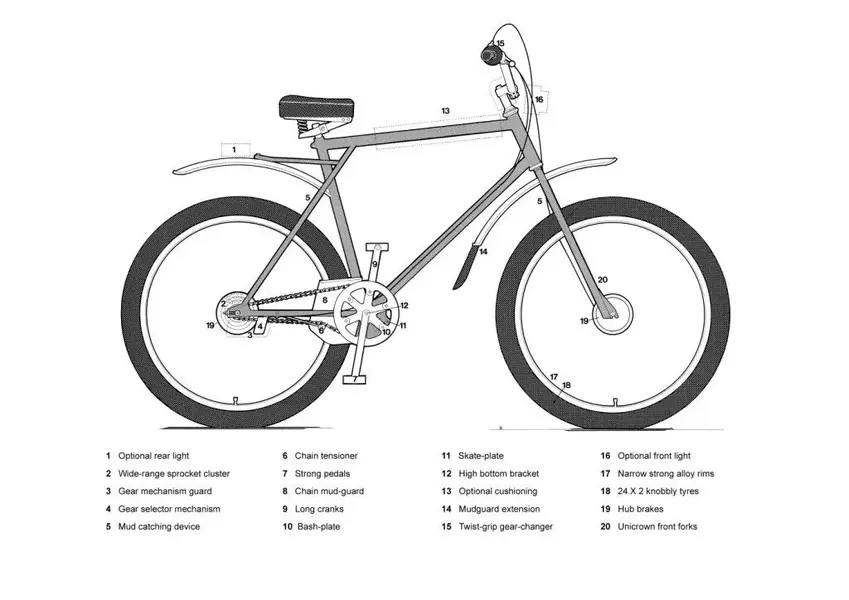
Apps then went on to design 650b and 700c bikes that were primarily designed for long distance all-weather off-road touring. In 1985 his ideas returned to smaller wheels with his Cleland Dingbat designs. Here, the primary focus was on agility and trials capability. Though fitted with wide-range gears and mudguards he would also use there bikes for touring. The Dingbat had a Rear: 550b rim fitted with a 65-484 Nokia Trials tyre and a front 600b rim fitted with a 44-531 Nokia Hakkapeliitta tyre:
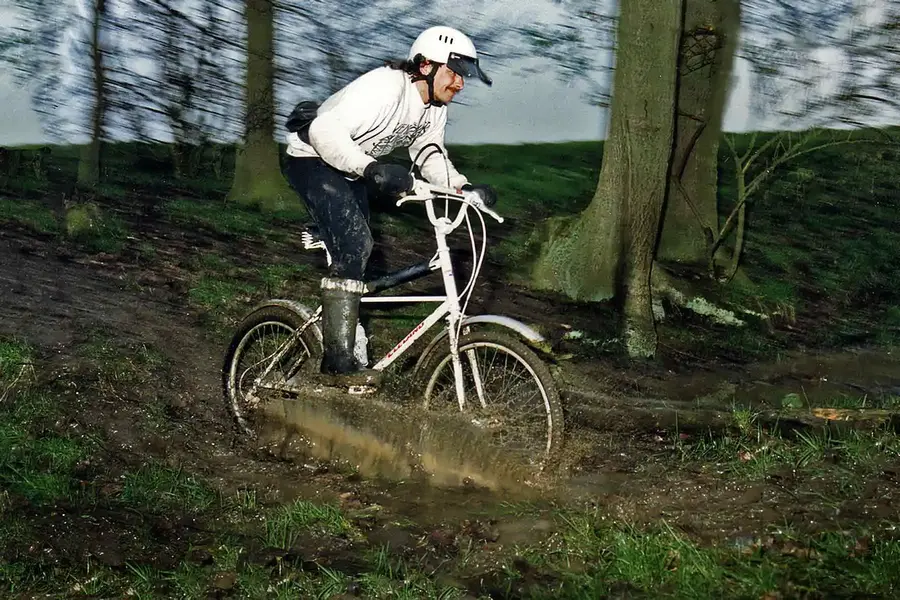 Here is a video that shows the Dingbat and other Clelands in action at the 1986 Wendover bash:
Here is a video that shows the Dingbat and other Clelands in action at the 1986 Wendover bash:The Start of British mountain biking video
Then in 1987 he designed the Clelandale which was built around a Cannondale 'Beast from the East' frame. For this lightweight bike he went back to the wheel-size that was commonly used by British 'dirt-track riders', including Apps, in the 1960s and 70s. 26″ X 1 3/8″ (37-590)
Again he fitted Nokia Hakkapeliitta tyres:
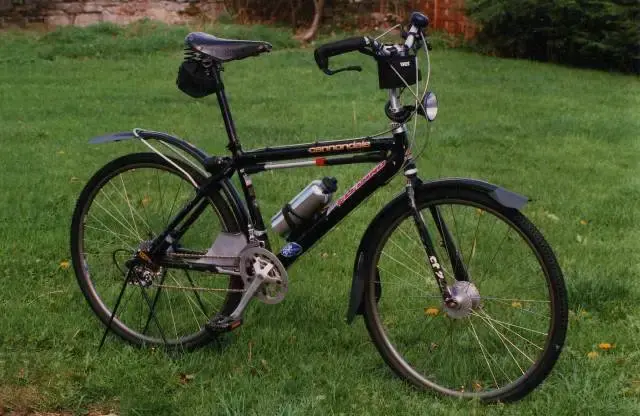
After a break from designing bikes, in 2006 Apps returned to focus on bikes with 700c wheels.
Other notable small wheeled off-road bikes include the 1985 English Cycles Rat, designed by Jeremy Torr, with its 20" rear and 26" front wheel:
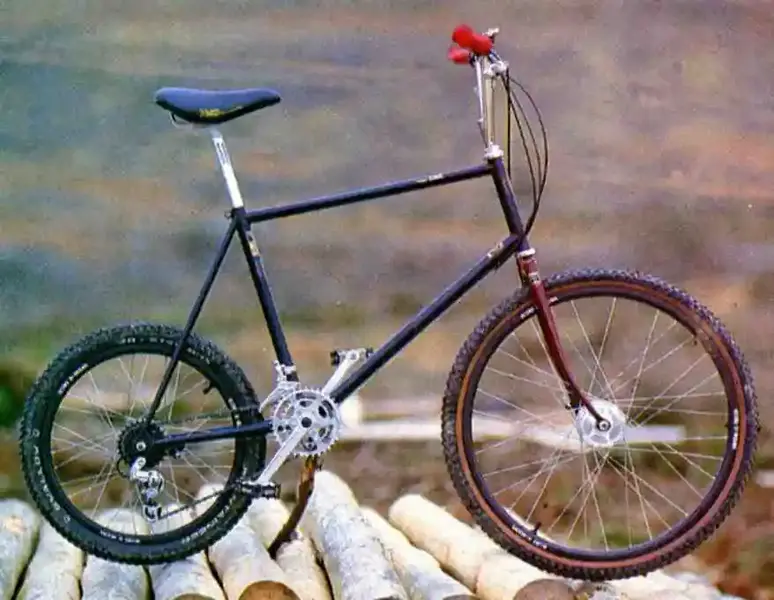
Also, the full 20" wheeled full-suspension Moulton AM-ATB of 1988:
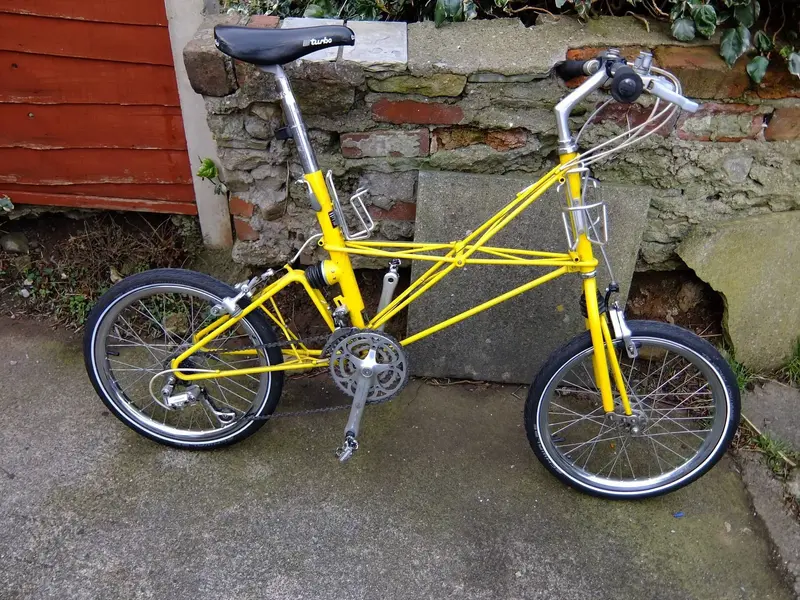
Last edited:
DrGooGoo
Retro Guru
Wow! That Moulton is cool. Full suspension in 1985!Lots of interesting information there, much of which I did not know. Thanks for posting.
In 1978, Geoff Apps' first serious off-road bicycle design shown below was specified to have 24" x 2" wheels.
View attachment 588336
Apps then went on to design 650b and 700c bikes that were primarily designed for long distance all-weather off-road touring. In 1985 his ideas returned to smaller wheels with his Cleland Dingbat designs. Here, the primary focus was on agility and trials capability. Though fitted with wide-range gears and mudguards he would also use there bikes for touring. The Dingbat had a Rear: 550b rim fitted with a 65-484 Nokia Trials tyre and a front 600b rim fitted with a 44-531 Nokia Hakkapeliitta tyre:
View attachment 588338 Here is a video that shows the Dingbat and other Clelands in action at the 1986 Wendover bash:
The Start of British mountain biking video
Then in 1987 he designed the Clelandale which was built around a Cannondale 'Beast from the East' frame. For this lightweight bike he went back to the wheel-size that was commonly used by British 'dirt-track riders', including Apps, in the 1960s and 70s. 26″ X 1 3/8″ (37-590)
Again he fitted Nokia Hakkapeliitta tyres:
View attachment 588339
After a break from designing bikes, in 2006 Apps returned to focus on bikes with 700c wheels.
Other notable small wheeled off-road bikes include the 1985 English Cycles Rat, designed by Jeremy Torr, with its 20" rear and 26" front wheel: View attachment 588340
Also, the full 20" wheeled full-suspension Moulton AM-ATB of 1988: View attachment 588341
Is that yours?
Lots of interesting information there, much of which I did not know. Thanks for posting.
In 1978, Geoff Apps' first serious off-road bicycle design shown below was specified to have 24" x 2" wheels.
View attachment 588336
Apps then went on to design 650b and 700c bikes that were primarily designed for long distance all-weather off-road touring. In 1985 his ideas returned to smaller wheels with his Cleland Dingbat designs. Here, the primary focus was on agility and trials capability. Though fitted with wide-range gears and mudguards he would also use there bikes for touring. The Dingbat had a Rear: 550b rim fitted with a 65-484 Nokia Trials tyre and a front 600b rim fitted with a 44-531 Nokia Hakkapeliitta tyre:
View attachment 588338 Here is a video that shows the Dingbat and other Clelands in action at the 1986 Wendover bash:
The Start of British mountain biking video
Then in 1987 he designed the Clelandale which was built around a Cannondale 'Beast from the East' frame. For this lightweight bike he went back to the wheel-size that was commonly used by British 'dirt-track riders', including Apps, in the 1960s and 70s. 26″ X 1 3/8″ (37-590)
Again he fitted Nokia Hakkapeliitta tyres:
View attachment 588339
After a break from designing bikes, in 2006 Apps returned to focus on bikes with 700c wheels.
Other notable small wheeled off-road bikes include the 1985 English Cycles Rat, designed by Jeremy Torr, with its 20" rear and 26" front wheel: View attachment 588340
Also, the full 20" wheeled full-suspension Moulton AM-ATB of 1988: View attachment 588341
- Feedback
- View
I would love to ride that Rat or the Moulton.
This is the best BotM in my opinion, not because the bikes are those I find most desirable, but because of all the fascinating information that has been shared afterwards.
This is the best BotM in my opinion, not because the bikes are those I find most desirable, but because of all the fascinating information that has been shared afterwards.
- Feedback
- View
The pictures of the Moulton AM-ATB first appeared in the UK cycling press in August 1988 and I rode one in the September. I did not buy one but my friend did. I do not know if he still has it.Wow! That Moulton is cool. Full suspension in 1985!
Is that yours?
In 1990 I bought a first generation Moulton-APB which was a budget version of the ATB. I still have that bike and the ride is similar.
The first large wheeled mountain-bike with front wheel suspension that I saw was a 700c Highpath-Springlite. This bike was designed by David Wrath-Sharman at Highpath Engineering in Guildford in 1987. The picture below shows the prototype bike after a suspension failure during testing:

Last edited:
Your 700 wheeled mtb make me think about old VCCP bikes, with ever some front supensions !
https://dirtmountainbike.com/news/mag-roots-vccp-paris.html
https://dirtmountainbike.com/news/mag-roots-vccp-paris.html
Similar threads
- Replies
- 43
- Views
- 11K
- Replies
- 75
- Views
- 29K